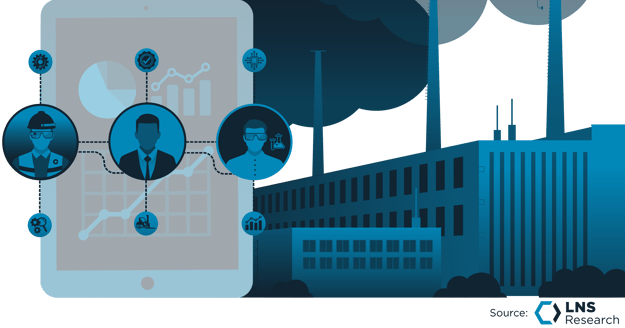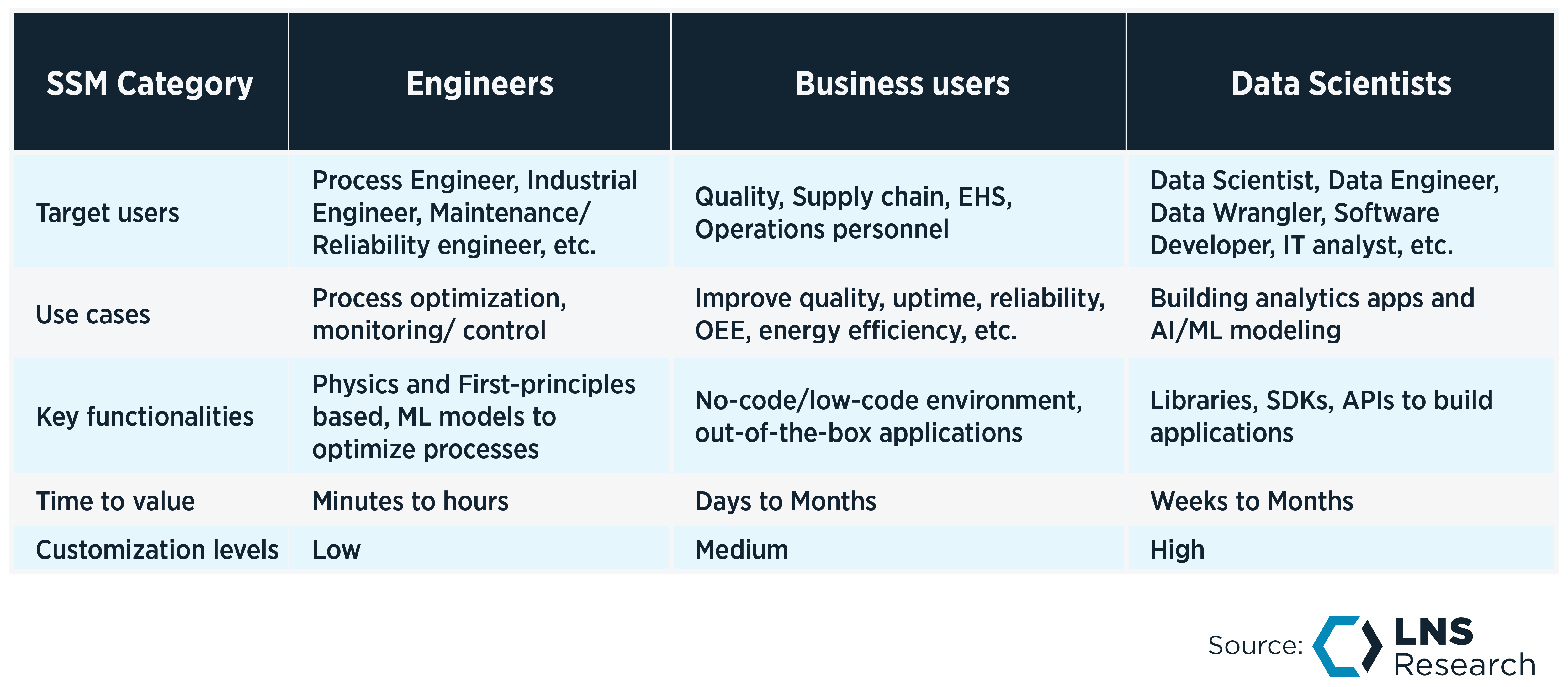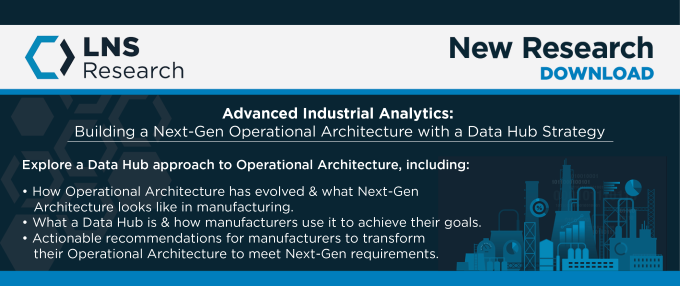In a previous blog post, we introduced Advanced Industrial Analytics (AIA) as a technology category and defined what it takes to provide competing software in this space. As part of that definition, we provided five must-have criteria for Advanced Industrial Analytics software:
-
-
-
The vendor must have a significant presence in industrial operations.
-
The software must provide a platform and/or a robust set of out-of-the-box analytics applications.
-
The software should be built on a digitally native, scalable, and flexible architecture.
-
Deliver Descriptive to Prognostic analytics capabilities, preferably within a closed-loop self-learning system that improves over time.
-
Ideally, the software must target multiple roles and levels across the organization.
An average small to midsize manufacturing company would require two, if not three, of these Advanced Industrial Analytics software, provided the underlying architecture is designed efficiently without many custom integrations.
Software Selection in an Overcrowded Vendor Landscape
Over the past few months, LNS Research has been working on a Solution Selection Matrix™ (SSM) to evaluate qualified vendors competing in this space. However, this comes with its own set of challenges. First, the sheer number of vendors to consider. Ranging from well-established Independent Software Vendors (ISVs) and Enterprise Resource Planning (ERP) vendors to large automation firms, numerous startups, and even major cloud infrastructure providers, there are hundreds of companies to consider. Even after filtering out a considerable number of vendors, we were still left with 30+ qualified vendors.
Second, the qualified vendors provide different types of analytics capabilities, serve different user personas, and don’t necessarily compete with each other for the most part, making the process of scoring them in the same matrix of little to no value to the end user.
Being such an overcrowded and fast-moving technology space, LNS Research believes that the majority of the vendors would be able to offer more clarity and distinguish themselves in the market by moving from a use case first strategy to one of user persona first.
In order to enable an apples-to-apples comparison of the different types of vendors and provide some simplicity and clarity to the overall space, LNS Research has classified the Advanced Industrial Analytics software providers into three categories. The categories, based on user personas and types of software providers, are listed below:
-
-
-
Advanced Industrial Analytics (AIA) for Engineers
-
Advanced Industrial Analytics (AIA) for Data Scientists
-
Advanced Industrial Analytics (AIA) for Business Users
Let’s take a closer look at each of these categories.

AIA for Engineers
The first category includes focused, self-service software that analyzes and visualizes asset and process parameters on factory floors. As the title suggests, these software are aimed at engineers responsible for monitoring assets and optimizing processes. This software must be strong in mapping and analyzing time-series data, but the ability to handle structured data is an added benefit.
Ideally, software in this category must provide out-of-the-box applications that offer several types of statistical, first-principles, optimization, and machine learning-based models that can be run without custom coding, along with the ability to save models and create workflows based on process parameters and events that trigger specific actions/notifications.
AIA for the Data Scientists
Although the second category is named after the Industrial Data Scientist role, this type of AIA software is also targeted toward enterprise-level data engineers, software developers, data wranglers, etc. Ideally, software in this category should provide some out-of-the-box applications but primarily go to market through a platform with toolkits for programmers and data scientists to build custom solutions and models.
The software may be customizable but are not intended as general programming or development environments and potentially offer pre-packaged algorithms, machine learning models, and/or toolsets for building analytics applications. It must also be able to integrate and interoperate with other applications/platforms across a cloud-to-edge infrastructure and provide open APIs to access structured, semi-structured, and unstructured data.
AIA for Business Users
The final and the most crowded Advanced Industrial Analytics category is aimed at business users, including quality, maintenance, manufacturing, EHS, etc. This category includes a broad set of companies ranging from start-up vendors with one focused product to industry stalwarts who offer advanced analytics as just one offering among a whole set of products and services.
All of these vendors have their own set of pros and cons and are best suited for different scenarios. For example, suppose a company already has a huge install base of a particular vendor’s MES and automation systems. In that case, it is only prudent to consider at least shortlisting their AIA software, while in other cases, it might make more sense to go with a pure-play vendor.
Again, it serves little to no purpose to the end user to compare these software in a single matrix, and for that reason, we have further split them into two sub-categories:
-
-
-
Pureplay: Companies with typically one product that offers AIA solutions across a few qualified use cases. These are mostly start-ups coming out of stealth mode over the past 5-10 years and have been gaining market share at an impressive rate, with double-digit CAGR and headcount numbers for the most part.
-
Product suite: The product suite categories include the large automation, ERP, PLM, and MES companies that have built or acquired complete software or a set of capabilities that collectively form an Advanced Industrial Analytics solution. These software are not these companies’ flagship products but supplement their existing portfolio of product suites.

To support this research, LNS has been evaluating Advanced Industrial Analytics software through a three-pronged approach. First, through a detailed survey of the qualified shortlisted vendor’s product and go-to-market approach, then by assessing technology and business briefings by the product and business leadership teams, and finally, through customer references and feedback. We will then consider these pieces of information and apply LNS’ collaborative 3P research methodology to score the vendors on their product, presence, and potential.
While most companies competing in this space offer software aimed at only one of these categories, a few companies have software that serve multiple personas and find themselves scored in more than one SSM category. However, readers should note that their product, presence, and potential scores will be based on how effectively they serve that particular persona and will most likely change for each category.
Summary & Recommendations
Advanced Industrial Analytics broadly impacts several facets of today’s manufacturing and Industrial Transformation. Over the past few years, the usage of and expertise in managing data and analytics has expanded from a selected few teams to being democratized across the organization.
As a result, hundreds of companies have built Advanced Industrial Analytics software that caters to one or more of the needs of today’s manufacturers. To guide manufacturers in making an educated selection of these software options, LNS Research has been working on Solution Selection Matrices to evaluate and compare this assortment of software across three categories.
Most vendors provide insights for cross-functional business use cases at the plant level. On the other hand, fewer vendors focus on the process engineer and the industrial data scientist. As a result, vendors may score in more than one matrix, though their scores may differ because each vendor has specific strengths and weaknesses in each category.
Here are some closing recommendations to companies undergoing a software selection process for their Advanced Analytics initiative:
-
-
-
Don't do analytics for analytics' sake: An Advanced Industrial Analytics initiative, like any other strategic initiative, should be aligned with the company's overall business objectives.
-
Fix your data first: It is easy to be tempted by the advanced capabilities flaunted by vendor offerings. However, good data is a fundamental prerequisite to good (and accurate) analytics.
-
Realize that you will likely need two, if not all three, types of advanced analytics software. Take a use case-based approach to drive your software selection process.
-
Beware of the Shiny Object Syndrome: Time to value, broad applicability to the targeted use cases, and ability to scale often trump the precision of the model or the elegance of the software.
